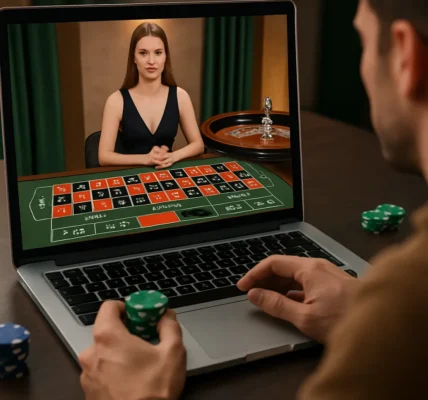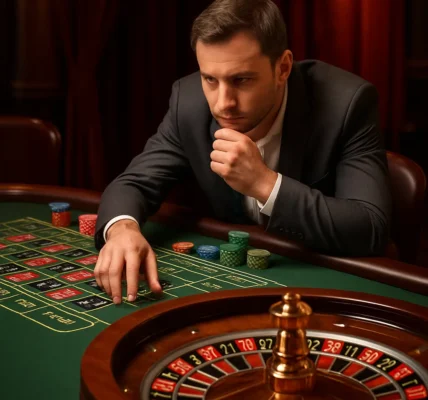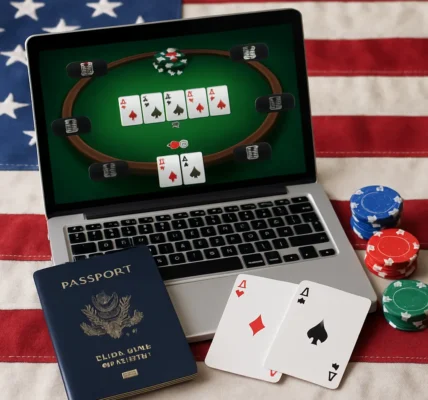So, you’ve caught the poker bug, huh? Or maybe you’ve watched a few too many late-night World Series of Poker marathons and thought, “I could do that… probably.” Whatever brought you here, if you’re looking to finally learn poker (for real, not just the rules your uncle taught you at Thanksgiving), this guide is for you. We’re going to get into the nitty-gritty of poker strategy, poker tips, and everything you need to know to take your game to the next level. I’ll walk you through the basics, some juicy advanced stuff, and the resources you’ll want to devour along the way. Don’t worry—I’ve been in your shoes, staring at a table full of confident faces, clutching a hand that might be amazing or utter garbage. Poker seems intimidating at first, but with a little patience (okay, and maybe some heartbreak), you’ll be making smarter plays before you know it!
Understanding the Fundamentals of Poker
Look, I know everyone wants to jump straight into crazy bluffs and big pots. Been there, done that, lost my stack in the process. But if you skip the fundamentals, it’s like trying to play chess without really knowing what a bishop does. Most of the epic poker fails (and wins) I’ve seen come down to the basics: knowing what hands beat what, and why your seat at the table actually matters. Poker isn’t just about luck—once you get this, you’ll notice how the same players keep winning in the long run. You’ll need a solid understanding of poker hands, positions, and a little thing called poker psychology (we all love a good mind game, right?). So, let’s start by brushing up on the absolute essentials before we get sneaky with strategies.
Basics of Hand Rankings
Honestly, if you only memorize one chart in your poker career, let it be the hand rankings. Seriously. Nothing is worse than confidently whipping over a flush and then someone else gently lays down a full house, sending your chips to the other side of the felt. (Been there. Ouch.) The pecking order of poker hands forms the backbone of every decision, strategy, and, let’s be real, every showdown story you’ll tell your friends. Whether you’re playing Texas Hold’em, Omaha, or one of the funkier variants, the standard hand hierarchy is pretty much universal. You want to internalize it so deep you could recite it in your sleep.
Here’s a handy table you can reference until you’ve got it down cold:
| Rank | Hand | Example | Notes |
|---|---|---|---|
| 1 | Royal Flush | 10♠ J♠ Q♠ K♠ A♠ | Basically unbeatable |
| 2 | Straight Flush | 6♥ 7♥ 8♥ 9♥ 10♥ | Five cards in sequence, same suit |
| 3 | Four of a Kind | 9♣ 9♦ 9♥ 9♠ K♦ | AKA “Quads” |
| 4 | Full House | 7♣ 7♦ 7♠ J♣ J♠ | Three of a kind + a pair |
| 5 | Flush | 2♣ 6♣ 9♣ J♣ Q♣ | Five cards, same suit, not in order |
| 6 | Straight | 3♠ 4♦ 5♣ 6♣ 7♥ | Five in a row, suits don’t matter |
| 7 | Three of a Kind | J♠ J♣ J♦ 5♣ 9♥ | Trips or “set” (if using both hole cards in Texas Hold’em) |
| 8 | Two Pair | 8♣ 8♠ 3♦ 3♠ A♥ | High pair counts first |
| 9 | One Pair | K♠ K♦ 6♣ 2♠ 7♥ | Just… one pair |
| 10 | High Card | A♣ 10♠ 8♦ 4♣ 2♥ | No pairs, nothing fancy |
If you want a funny way to remember: “Flush beats straight, but lost to a full house.” Trust me, you’ll never forget it after your first dramatic showdown. Learning poker hands by heart is an absolute must. No exceptions!
The Importance of Position
Now, this is one of those nuggets no one bothered to tell me early on and I wish someone had. Position in poker is sort of like having the last word in an argument… it’s powerful. To put it simply, “late position” (meaning you’re one of the last to act in a betting round) is a massive advantage. Why? Because you get to watch everyone else make decisions before you do. It’s like seeing everyone else’s poker math play out in real time.
Playing poker online makes this even more obvious—watching players in early position try to force pots can be painful. I’ve gotten away with sketchy bluffs just because I had the button (the absolute best seat, aka “dealer position”). The earlier you act, the less info you have, and the more careful you should be with your chips. Poker strategy 101: play tighter early, looser late, and always be at least a little suspicious of that guy raising from under the gun.
Learn how to value position and you’ll find yourself winning more—sometimes even with crummier hands.
Developing Your Poker Strategy
Okay, let’s get to the fun part: actually building up your poker strategy once you’ve nailed the basics. A lot of people get stuck here, thinking they need to learn 1,000 complex moves. Not true. In fact, most pros will tell you, sticking to a few strong fundamentals can take you way further (and save you a lot more money) than trying every crazy “move” you found on YouTube. This is where poker tips start to get interesting. You’re going to learn how to spot good starting hands, when to get aggressive, and how to sprinkle in some well-timed bluffs. And don’t worry—we’ll talk a bit about poker math, but I promise not to make it too painful (math-phobes welcome).
Starting with Tight and Aggressive Play
Ask any successful poker player, and they’ll tell you: Tight and aggressive (TAG, if you want to sound like you know your stuff) is where you want to start. I learned this the hard way after bleeding chips by trying to see every flop. Playing tight means you’re only getting involved with strong hands, while aggressive means you’re not just calling—you’re betting, raising, and generally making it expensive for others to see more cards.
Why does this work? Because when you do play a hand, opponents (who notice you’re not reckless) will start worrying that you’ve actually got the goods. Plus, if you’re always just calling, you’re letting other people dictate the size of the pot. That’s not ideal for your bankroll management.
A typical beginner mistake? Playing too many hands, just out of boredom or FOMO. (Been there! We all have.) Sticking to the top 10–15% of starting hands for each position is a solid place to begin. Then, as you get more comfortable, you can open up your range and get trickier.
Remember, poker isn’t about being in every pot—it’s about winning more when you’re ahead and losing less when you’re behind. Tight and aggressive gets you there, trust me.
Mastering Bluffing Techniques
Bluffing is the spice of poker. The stuff movies are made of. But honestly, it’s also the fastest way to exit a tournament early if you overdo it without reading the table. The best bluffs are carefully calculated and only used in the right spots—which, believe it or not, is less often than most rookies think.
It took me a few embarrassing all-in bluffs to realize: Timing is everything. If you’re up against players who can’t lay down a hand, don’t even bother. But if you’ve noticed they’re folding to pressure, then it’s your time to shine. Bluffing should always be supported by a believable story—your actions up to now should make your big bet look legit.
Here’s a quick checklist for a successful bluff:
- Consider your table image (do you seem tight, wild, or unpredictable?)
- Think about what your opponent thinks you have.
- Make sure the board supports your story (don’t pretend you’ve hit that flush when three of the suit aren’t even out there—rookie move!)
- Pick the right target: Don’t try to bluff the calling station who never folds.
- Know when to quit—don’t double or triple barrel if they keep calling. Sometimes you just gotta let it go.
The adrenaline rush of a successful bluff is unreal, but poker strategy is ultimately about balance—pick your spots.
Pot Odds and Expected Value
Now, let’s talk about the mathy side of poker—don’t worry, you don’t need a PhD to get this, just a little common sense. Pot odds and expected value (EV) are crucial if you want to avoid costly mistakes. I’ll admit, when I first started, I’d just go by gut feeling (“I think I’ll hit my flush!”)—which explains my rapidly shrinking chip stack. Learning the basics of poker math is surprisingly empowering.
Pot odds are basically a fancy way of asking: “Is this call worth it, based on the size of the pot and the bet I have to call?” If you’re being asked to call $50 into a $200 pot, but your chances of making your hand aren’t great, that’s an easy fold. EV, on the other hand, is all about the long-term results. You don’t chase inside straight draws just because it “feels lucky.” You chase when the odds and the payout make it smart.
Here are some basics for quick poker math at the table:
- Count your “outs”—the cards that’ll help you improve.
- Multiply your outs by 2 (for each card to come) to get a rough % chance of hitting.
- Compare this to the percentage chance you need, based on the size of the pot versus your call.
- If your % chance is better than the pot odds you’re offered, call. If not, easy fold.
Nobody expects you to be a math wizard, but understanding pot odds and expected value can turn poker from a guessing game into a profitable one—over the long haul, anyway.
Enhancing Your Poker Skills
Alright, you’ve stuck with me this far, and I bet you’re itching to start crushing tables. Before you do, know this: Even seasoned poker sharks never stop learning. There’s always something new—whether it’s recognizing tells, tackling a new variant, or refining your poker psychology skills. If you want to step up from “just another player” to someone feared at the table, focus a little more on the mental game and adaptability. I once thought I’d figured it all out—until some genius monkey-wrenched my strategy at a home game with a ridiculous bluff. Adapt or get left behind, my friend.
Recognizing Opponent Patterns
If poker had a subtitle, it would be “Spot the Pattern.” Seriously, some sessions feel almost like detective work. People tend to repeat tendencies—some are always chasing draws, others fold too easy, and a few seem to float through hands like some poker Zen master (they’ve got weaknesses, too, trust me). The key is picking up on betting patterns, timing tells, and tiny psychological cues.
I once played with a guy who’d scratch his ear every time he was bluffing. No joke. The first time I thought, “Weird habit,” the second time his bluffs made sense, and the third time I took half his stack. That’s an obvious tell, but betting size, how quickly someone acts, and even how chatty they get mid-hand are all pointers. Online poker is trickier for this, but timing (do they bet instantly or tank?) still gives clues.
Recognizing these patterns lets you tailor your own poker strategy—maybe you start calling down lighter against someone who’s clearly a bluff-happy maniac, or fold more often to that stone-cold nit. Trust your observations; over time, you’ll spot weaknesses and jump on them before your opponents even know what hit them.
Adapting to Different Poker Variants
Let’s be real—most people start with Texas Hold’em, and there’s a good reason for that: It’s simple on the surface but endlessly deep. But if you stick to only one game, you’re missing out, and sometimes even limiting your edge. Every poker variant shakes things up, forcing you to adjust your strategy and, honestly, keeping the game fun.
For instance, Omaha is a wild ride with four hole cards, making the odds and top hands a totally different animal. Stud games and mixed games? Welcome to a world where memory skills and quick reads are even more valuable. The big thing is that, while the essence of position and aggression remains, hand selection, bluffing, and the very tempo of the game shift.
If you want to be the kind of player who can sit down anywhere and not feel out of your depth, start dabbling in other variants. Play a little Omaha, Five Card Draw, or even Razz. You might come to love the new challenge, and the experience will absolutely refine your broader poker skills.
Here are a few things to focus on when jumping into a new poker variant:
- Study the specific hand rankings and rules (they can differ a lot!).
- Watch out for the value of starting hands changes—what’s powerful in Hold’em might be weak in Omaha.
- Pay attention to betting structures—limit games play way different from no-limit.
- Observe experienced players and try to spot what they’re doing differently.
- Remember: patience and observation are your best friends until you get the hang of things.
Poker is kind of like life—if you get stuck in one way of thinking, you’ll get left behind. So embrace the variants!
Resources for Learning Poker
Alright, you’ve got your feet wet with the basics and maybe even taken down a couple (small) pots. But if you really want to learn poker and evolve your game, you need more than just experience. The truth is, with the explosion of online poker and forums, the resources available today are insane compared to just twenty years ago. Back then, you’d have to befriend a cranky regular at your local casino or read books thick enough to stop a bullet. Now? Courses, videos, software, Twitch streams, and so much more are just a click away. Here’s where to dig in. Oh, and don’t skip this—everyone I know who’s really leveled up has leaned hard on at least a couple of these.
Recommended Books and Courses
Old school or new school—it doesn’t matter. Some lessons are timeless, and the best poker books are like well-worn road maps to the money. I remember slogging through Doyle Brunson’s Super System as a newbie and feeling both inspired and totally lost at the same time (pro tip: don’t try all the tricks until you understand why they’re used). These days, there are also countless online poker strategy courses, from free YouTube series to paid masterclasses taught by, weirdly enough, people you’ve seen on TV.
Here are two lists—one for books and another for popular courses—that I or my poker pals swear by:
Top Poker Books You Should Read
- Super System by Doyle Brunson – The original “poker bible.”
- The Theory of Poker by David Sklansky – If you want to understand the “why” behind every play.
- Harrington on Hold’em by Dan Harrington – Especially good for understanding tournament play.
- Elements of Poker by Tommy Angelo – Equal parts psychology, tactics, and gritty poker wisdom.
- Modern Poker Theory by Michael Acevedo – For when you’re ready to get mathy and dive into GTO (game theory optimal) strategy.
Great Online Poker Courses
- Run It Once (Phil Galfond’s training site) – Deep-dive video lessons at all skill levels.
- Upswing Poker Lab – Focuses on a mix of strategy, hand reviews, and minds games.
- PokerCoaching.com (Jonathan Little) – Excellent for live play breakdowns and quizzes.
- MasterClass with Daniel Negreanu – Just really fun and inspiring to hear straight from a pro.
- Red Chip Poker – Full of actionable concepts for crushing cash games online and live.
Pick a book or course, work through it, and actually take notes. The more you study, the more small but game-changing ideas you’ll add to your arsenal.
Online Communities and Forums
I wish I’d jumped into online poker communities sooner. They’re full of people at every level, sharing hands, giving advice, and even sometimes just venting after a soul-crushing beat. Sites like TwoPlusTwo are legendary for a reason—post a hand and you’ll get five different takes, which, while occasionally overwhelming, can give you new angles on your own play. Discord groups are another new favorite: instant feedback, strategy talk, or even just getting a sweat going during a big tournament.
Here’s what’s so cool—sometimes you’ll spot poker pros participating and dropping free poker tips in between the memes. No matter your style, there’s a forum or group for you. A few recommendations:
- TwoPlusTwo Forums – Classic, deep strategy discussions for every variant.
- /r/poker (Reddit) – Lighter, but very active and accessible.
- Poker Discord Groups – Much more conversational and live.
- PocketFives – Especially strong for online tournament regulars.
- Facebook Groups (search “poker strategy”) – Casual but can be useful for finding local games too.
Be friendly, stay humble, and ask questions. Most folks are happy to help newbies as long as you come in with a little respect for the game.
Poker Software Tools
Okay, if you really want to geek out—and absolutely crush online poker—poker software tools are where it’s at. You don’t need to start here, but even a basic hand tracker can open your eyes to leaks in your play you never noticed. Most pros use these tools religiously, and if you’re serious about learning poker, they’re hard to beat.
The biggest category: tracking and HUD (heads-up display) tools that break down everything you and your opponents do. Others include solvers that help you analyze hands after the fact, and equity calculators that make poker math a cinch. Even if you never use a HUD in a live game, the insights you gain transfer directly to table reads and strategy IRL.
- PokerTracker 4 – Probably the most popular hand history tracker and HUD out there.
- Hold’em Manager 3 – Similar to PokerTracker, with its own features.
- GTO+ or PioSolver – Get ready to have your mind blown by solver technology.
- Equilab – A free equity calculator; super valuable for practicing hand analysis.
- ICMIZER – Great for breaking down late-tournament play and payout impact in MTTs.
Start simple. Even just reviewing your own play with basic tracking can add a whole new dimension to your poker strategy.
Conclusion: Putting It All Together
Whew—that’s a lot to take in, right? But don’t let the avalanche of info scare you. Every shark at your table started out fumbling with the basics, making questionable bluffs, and asking “Is this hand good?” way too often. If you want my honest advice, here it is: Focus on the fundamentals, play a lot (online poker is a bonkers good training ground), learn from your beats, and just keep studying and adapting.
Poker strategy isn’t a magic trick. It’s a mix of math, psychology, discipline, and, every so often, daring to outplay someone who least expects it. Use poker tips from this guide, leverage books, communities, and tools, and keep your mind open. And don’t forget—bankroll management is the unsung hero that keeps you in the game long enough to really master it.
The most important skill, hands down? The willingness to keep learning. The pros are obsessed with finding tiny improvements, and you should be too. So, shuffle up and deal—your next winning session is just around the corner. Good luck, and may all your poker hands be monsters!








